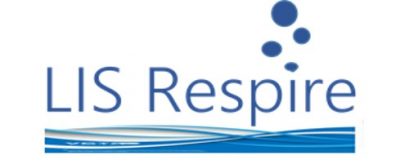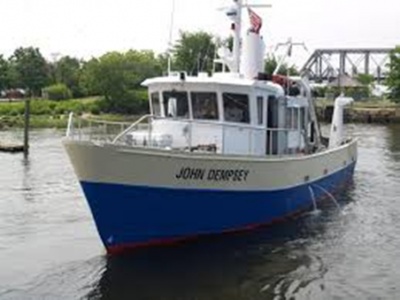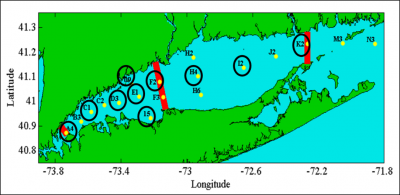The Long Island Sound (LIS) Respire Program & Alkalinity in Long Island Sound Embayments (ALISE)


This research project has resulted in the first comprehensive and simultaneous alkalinity and carbonate system parameter distributions in LIS. The study managed to maintain its carbonate system work throughout COVID and has resulted in the potential long term addition of carbonate system parameters to the LIS water monitoring program which PI Vlahos’s team has proposed as a result of the study. The study identified significantly low seasonal aragonite saturation values along the LIS central axis that persist longer than hypoxic conditions and is proposing that aragonite saturation be used as an indicator to set new TMDLs for LIS. This work has resulted in several conference presentations, one published and 1 submitted manuscript to date. Stay tuned for at least two more planned manuscripts to be submitted in 2022.
List of publications/presentations: *DG student lead author
- Whitney, M.M., Vlahos, P. (2021) Reducing Hypoxia in an Urban Estuary Despite Climate Warming. Environ. Sci. & Technol. 55 (2), 941-951. DOI: 10.1021/acs.est.0c03964
- *Barrett, L. Vlahos, P., Whitney, M.M., Vaudrey, J. (2022) Alkalinity and carbonate system trends in Long Island Sound. Estuaries and Coasts (submitted).
- *Barrett, L.,Vlahos, P. (2021) Internal consistency of the inorganic carbon system in Long Island Sound.Biennial Coastal and Estuarine Res. Fed. (CERF November 2021).
- *Barrett, L. Vlahos, P. (2021) Over-specification of the inorganic carbon system of Long Island Sound. Am. Soc. of Limnol. & Ocean. (ASLO February, 2021).
- *Barrett, L., Vlahos, P. (2020) Carbonate System Dynamics in Long Island Sound. The Nat. Coastal Estuarine Summit (September, 2020).
Updates:
- Final RESPIRE monthly sampling in October 2021
- Monthly sampling resumes in March 2021
- January 2021 – First LIS-Respire publication
- Diurnal respiration experiments (July-October 2020)
- Alkalinity cruise resumes July 2021 through November 2020
- April/May (2020) cruises are cancelled due to Corona virus
- March (2020) the 10th cruise is completed.
- February 2020, Lauren Barrett presents LIS Respire results at the Ocean Sciences Meeting in San Diego, CA.
- January 11th 2020, Lauren Barrett presents Shell Day results to the Shellfish Commission
- December (2019) The 8th Respire cruise is completed focusing on underway measurements
- November (2019) The 7th Respire cruise with full discreet sampling is completed
- October (2019) The 6th Respire cruise is completed focusing on underway measurements
- Sept (2019) To date 5 research cruises have been completed successfully and sample analyses is underway!
- August (2019) The project joins the National Shell Day event as Connecticut’s alkalinity analysis center.
- June (2019) Initial sampling cruise begins!
- May (2011) The project’s Quality Assurance Plan has been approved by the Environmental Protection Agency and research is now underway.
Objectives:
| 1)To measure respiration rates and biological oxygen demand (BOD) at 10 Long Island Sound (LIS) water quality stations over the project period.
2)To measure key biogeochemical parameters at these stations (pCO2 and total alkalinity (TA)), in addition to those already measured in the LIS surveys (pH, nutrients, dissolved oxygen (DO), chlorophyll a and organic carbon).
3)To conduct incubations on dissolved and particulate organic carbon (DOC, POC) that measure degradation rates at 10 sites across LIS to complement respiration studies.
4)To evaluate the above values across LIS spatially and temporally to begin the foundational work for a combined LIS biogeochemical model that considers respiration in terms of season (i.e. temperature (T), salinity (S), stratification), location, depth, DOC and POC lability and important biogeochemical parameters.
5)To conduct a LIS DO balance for LIS from 1991 to present.
6)To ascertain the utility of adding respiration and/or inorganic carbon components to the Long Island Sound Water Quality Monitoring Program. |
 Figure 1: RV John Dempsey will be the research platform for the LIS Respire program. Figure 1: RV John Dempsey will be the research platform for the LIS Respire program.
Figure 2: LIS Respire sampling stations (black open circles).
|
